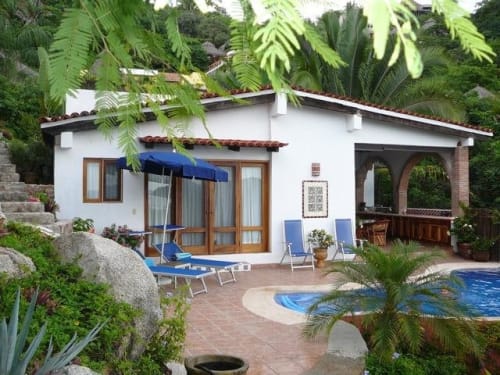SayulitaLife.com members can easily save favorites for vacation rentals, local businesses, real estate and more.
Sign In Create free accountList Your Property
Bargain Hunting South of the Boarder by Benedict Mander-Financial Times
Bargain-hunting south of the border
By Benedict Mander
Published: November 11 2005 in the U.K.'s Financial Times
The Mexican property market has long benefited from being situated next to what is possibly the largest group of second-home buyers in the world, luring Americans and Canadians to a tropical coastline that is prettier and less expensive than their own.
But cross-border property deals have surged to a new level in the past decade since the enactment of the North American Free Trade Agreement (Nafta), which eliminated legal uncertainties and onerous procedures that had deterred many foreigners from buying in Mexico. According to the US National Law Center, American and Canadian property ownership, which accounts for 90 per cent of total foreign ownership, has more than doubled since 1994 in key areas of the country. As a whole, foreign ownership is rising 10 per cent per year, compared with a 5 per cent growth rate before Nafta.
And, “frankly”, says Law Center president Boris Kozolchyk, “our estimates are very conservative.” He cites places such as Rocky Point, on what is being marketed as the Sonoran Gold Coast. Overlooking the Sea of Cortes, on the mainland across from the peninsula of Baja California, it is practically a drive-in market for US buyers, and he says he wouldn’t be surprised if foreign ownership had more than doubled their there since Nafta’s passage.
Popular areas outside his study, such as Puerto Vallarta further down the Pacific coast or Cancun on the Caribbean, which is popular with buyers from the eastern US, would probably show similar increases, he adds. And although the Maya Riveria, including Cancun, was decimated by Hurricane Wilma last month, recovery is under way and any drag on the property market is expected to be short-lived
Indeed, says Bruce Greenberg, an international real estate consultant in Tucson, Arizona, the hurricane is unlikely to distract buyers from the long-term benefits of owning property in Mexico post-Nafta. The most important change, he says, is improved legal security. “For a long time there was a problem with title insurance [which establishes clear ownership of a property], but this risk has been reduced, and issues of corruption are being resolved. Mexico has become a much safer investment.”
Bob Stanley, a Houston-based property appraiser who advises US buyers in Mexico, agrees. “I would not buy anything without title insurance – I wouldn’t touch Mexican property without it,” he says. In the past, he explains, many hasty buyers discovered only after closing on a property that their dream house was located on communal ejido land, which is jointly owned by a group of people.
Another key Nafta-related development was the introduction of a law enabling foreigners to buy beachfront homes. Technically the constitution still forbids non-Mexicans from owning property within 50km of the coast. But the introduction of fideicomisos, or bank trusts, which can be extended indefinitely, has skirted this problem by allowing investors to own through another entity.
Demographic trends are also causing the Mexican market to flourish, says Rogerio Basso, a real estate analyst for Ernst & Young in Miami. “The aging baby boomer generation – retiring, and with kids out of school [and] greater disposable income and more free time – needs to do something with its assets,” he says.. “There are certain coastal destinations in the US where prices are becoming prohibitive, but looking abroad they can find more value.” According to some estimates, there are now as many as 100,000 Americans choosing to retire to Mexico every year.
And many have found their homes to be excellent investments. Greenberg estimates that average appreciation rates on Mexican property have been 15-20 per cent in the past five years, and even higher in certain luxury developments. The massive US influx into the Baja California market, particularly in the area around Cabo San Lucas at the tip of the peninsula, has helped make it one of the more expensive areas in Mexico.
Still, prices are up to three times lower than in San Diego on the other side of the border, while still suiting the needs and tastes of homeowners with US Californian lifestyles. And there are several up-and-coming areas in Baja where analysts still see value. “Loreto Bay is probably one of these destinations that still has room for appreciation,” says Basso, referring to the town on the shores of the Sea of Cortes well north of the more developed areas between La Paz and Cabo San Lucas.
Similarly, while Puerto Vallarta has seen property prices triple since 1990, Nayarit, a largely undeveloped state further north, offers an equally pretty coastline, a hilly backdrop, lush vegetation and many more bargains.
Gina Tanner, a Los Angeles attorney, bought her hilltop second home with a garden and ocean view in Sayulita because there is an airport within 40 minutes’ drive but it “still [has] the feeling of a pueblo”.
“The buying experience was very easy,” adds the former estate agent, who says she would “never buy a property unless it was a damn good deal”. “We didn’t feel uncomfortable at all.”
She does advise househunters in Mexico to “find a good realtor”, however. “There is a tremendous opportunity for people who want to invest in Nayarit, but if you don’t have someone to guide you through the process you may lose the money,” she explains.
Most estate agents in Mexico recommend buying beachfront property, since demand is only likely to increase. Even in well-developed areas, coastal homes are still being snapped up. Stanley cites a 68-condominium project in the classic Caribbean resort of Playa del Carmen on the Yucatan peninsula, which broke ground in November 2004 and is already almost sold out.
Mexico’s National Fund for the Promotion of Tourism is concentrating on developing five specific areas – Cancun, Cabo San Lucas, Huatulco, Ixtapa and Loreto – pushing for infrastructure improvements likely to propel growth. But those well-trodden places account for a tiny proportion of the roughly 5,800 miles of Mexico’s coastline, to say nothing of its inland treasures – although lesser-known areas may lack the amenities and easy access enjoyed by the main resort areas.
Charles Alm, an American buyer, is currently looking for property in Mexico with two friends because “it seemed like the nexus of price, proximity, and stability”. But they are focusing outside established resorts in less developed areas north of Ixtapa on the Pacific and islands off the Caribbean state of Quintana Roo. “Being on the beach – or at least in a beach town – is a requirement as is finding a location that hasn’t yet been ‘discovered’,” Alm says. “We’re looking for a sunny place with substantial growth possibilities and relatively low capital requirements [that we can all use] maybe one week a year and a few weekends here and there on our own.”




